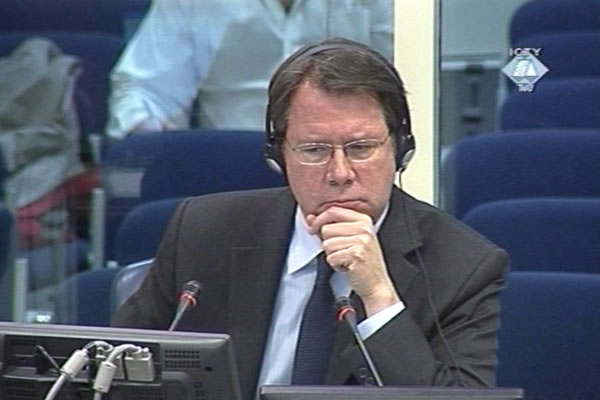Home
‘ORGANIZED’ OR ‘ORDERLY’ MOVEMENT OF REFUGEES
Noting that the RSK authorities were responsible for the exodus of Serbs from Krajina in August 1995, General Ante Gotovina's defense counsel reminded the prosecution witness Edward Flynn that in a previous statement he had talked about ‘a well-organized movement’ of the refugees. The witness amended his statement, saying that it was better to say the movement was ‘orderly’
 Edward Flynn, witness in the Gotovina case
Edward Flynn, witness in the Gotovina case On the last day of his evidence, Edward Flynn, former head of the UN Human Rights Action Team, was cross-examined by the defense counsel of General Ante Gotovina. He argued that the Serb civilians had fled before the arrival of Croatian army and police to Krajina and that their exodus had been organized by the Krajina Serb authorities. Luka Misetic, Gotovina's defense counsel, used the statement the witness gave to the defense team investigators this year. According to the defense, on that occasion Flynn said that the Serbs’ exodus from Krajina in August 1995 was 'rather well-organized’. According to the witness, it was similar to what happened four years later when Serbs left Kosovo before the arrival of the NATO troops.
The witness couldn't remember if that was exactly what he had said. He did allow the possibility that he hadn’t expressed himself precisely enough. Instead of 'well-organized' it would be better to say that the movement of civilians was 'orderly'. This means that they walked along the road in a column – there was no chaotic fleeing across the mountains. In his opinion, this was because the Krajina Serbs had obviously known that the Croatian forces might launch an attack. Therefore, they 'planned in advance where the civilians would withdraw if it happened'.
Gotovina's defense continued with its efforts to contest the allegation of the excessive shelling of Knin and other towns and villages in Krajina during Operation Storm. The witness agreed to a certain extent, saying that he expected he would see more damage to civilian buildings when he first entered Knin on 7 August 1995. He gave an example: the city hospital had sustained only slight damage caused by a single mortar shell exploding.
In the days to follow, however, the witness saw more and more burned down houses. This reached its peak between 15 and 20 August 1995. The villages around Knin, Obrovac and Drnis were on fire; he estimated that about 500 houses were burned down. Some other UN military observers estimated this number to be larger than 10,000. When he was asked to explain the discrepancy, Flynn said that military observers moved around in Krajina more than the members of his Human Rights Action Team. They had more vehicles at their disposal and they could deal with the issue of burned down houses more systematically. The number he presented was just an estimate and he was careful not to 'exaggerate'.
In his re-examination, the prosecutor focused on responding to the allegations Ivan Cermak's defense counsel presented in the cross-examination of the witness. According to the defense, Cermak was authorized only to 'coordinate the work of the police and the army' and not to issue orders to them. Prosecutor Mahindaratne presented the order Ivan Cermak issued on 8 August 1995, ordering the civil and military police to let the UN forces pass through Krajina freely. As Flynn said, this shows clearly that these forces were under Cermak's power.
The trial of Croatian generals Ante Gotovina, Ivan Cermak and Mladen Markac charged with crimes in Krajina in the summer of 1995 continues on Monday.
Linked Reports
- Case : Gotovina et al. - "Operation Storm"
- 2008-04-10 DEFENSE: CERMAK DID NOT ISSUE ORDERS – HE COORDINATED THINGS
- 2008-04-09 SYSTEMATIC CAMPAIGN OF ARSON AND DESTRUCTION
- 2008-04-08 ONE PLUME OF SMOKE FROM SEVEN DIFFERENT ANGLES
- 2008-04-14 HOW MANY DEAD IN KNIN HOSPITAL?
- 2008-04-15 WHO SHELLED KNIN?
- 2008-04-16 AUTHORITIES COULD HAVE PREVENTED ARSON AND LOOTING
